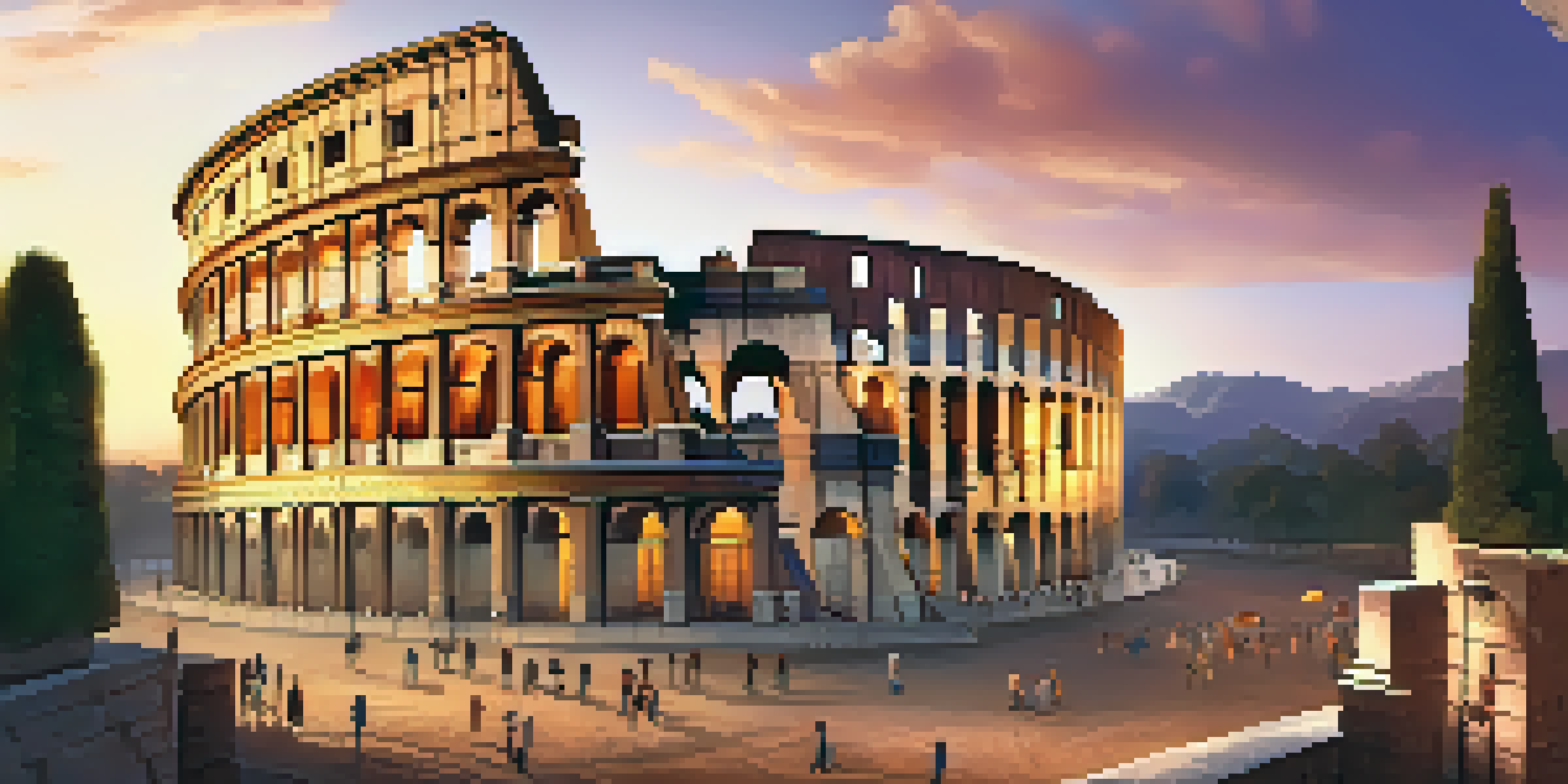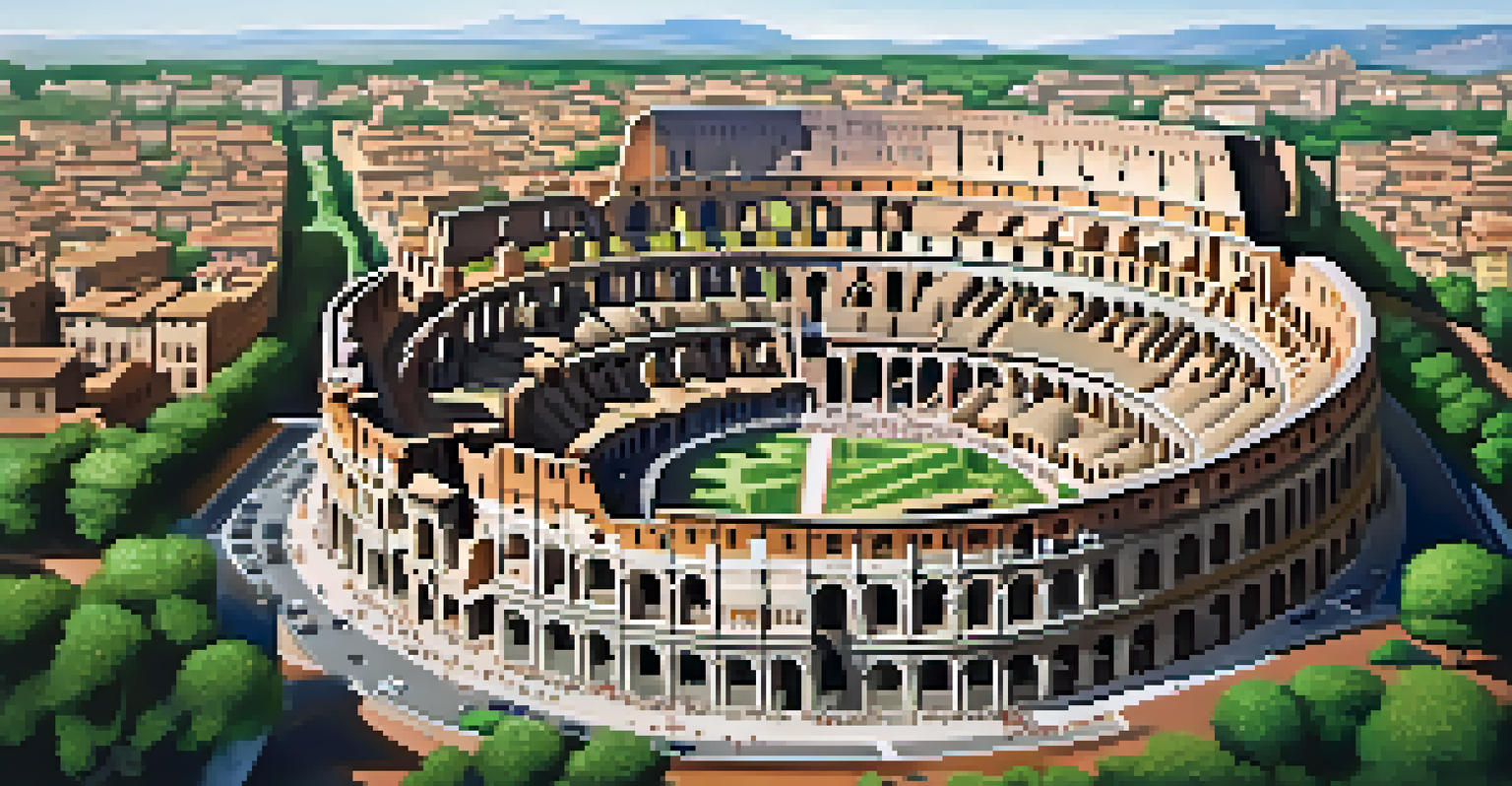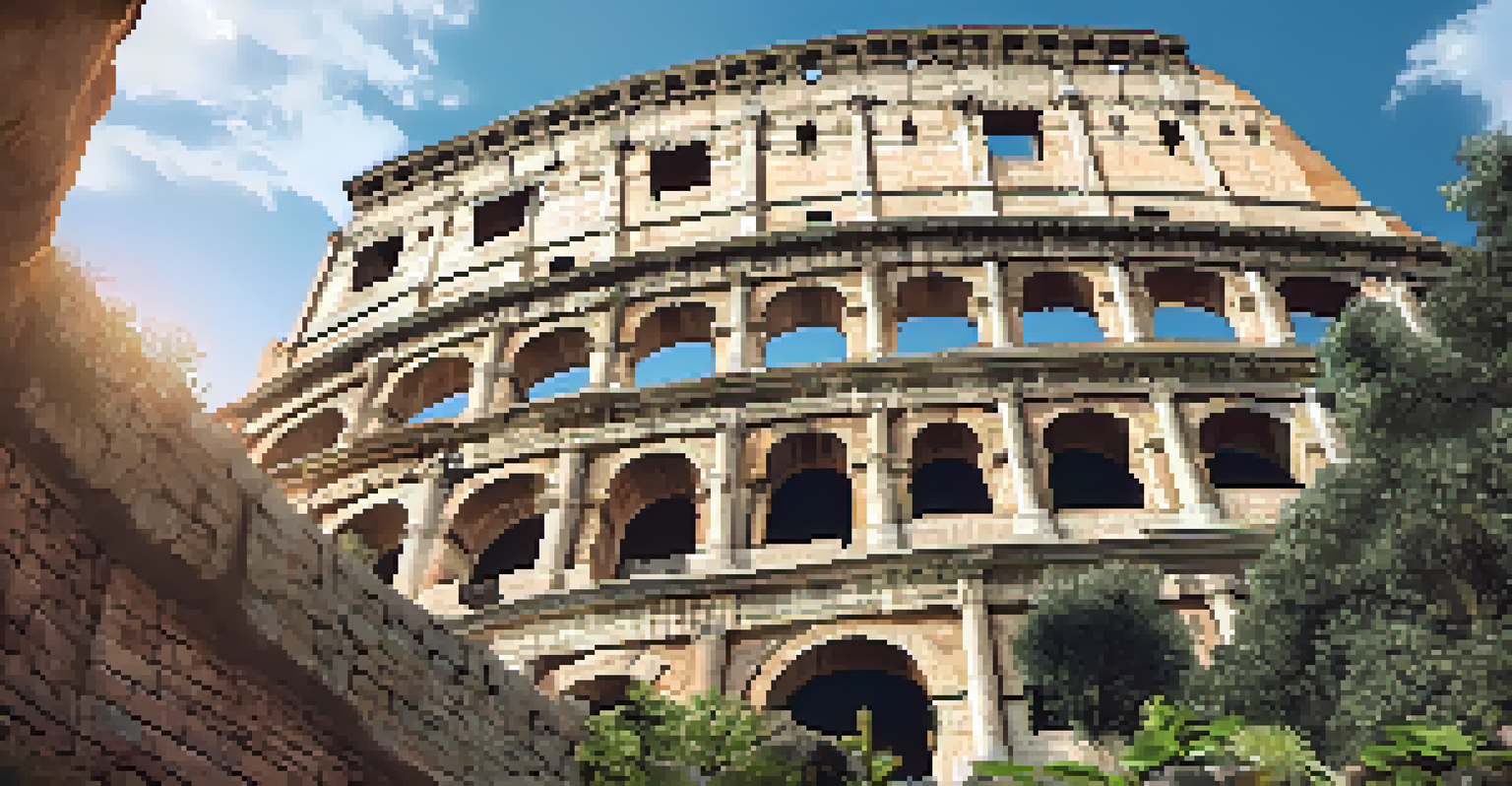The Colosseum: Rome's Iconic Arena and Its Historical Tales

The Colosseum: An Architectural Marvel of Ancient Rome
The Colosseum, also known as the Flavian Amphitheatre, stands as a testament to ancient Roman engineering. Completed in 80 AD, it could hold up to 80,000 spectators who gathered to witness thrilling events. The impressive use of arches and concrete allowed this grand structure to endure the test of time, making it a symbol of Rome's architectural prowess.
The Colosseum is a monument to the Roman people and their achievements, capturing the spirit of an empire that shaped the world.
Its elliptical shape and tiered seating not only provided excellent views for spectators but also showcased the Romans' advanced understanding of crowd management. The design facilitated easy access and exit, allowing thousands to enter and leave the arena swiftly. This innovative approach to public structures has influenced many modern stadiums and arenas.
The Colosseum's architecture reflects not just functionality but also the grandeur of the Roman Empire. Adorned with statues and intricate details, it served as a canvas for showcasing Rome’s wealth and power. Today, it is not just a ruin but a remarkable piece of history that continues to inspire architects and engineers around the world.
A Venue for Gladiatorial Combat and Public Spectacles
From its opening, the Colosseum was primarily used for gladiatorial contests and public spectacles, captivating the Roman populace. These events ranged from bloody battles between gladiators to elaborate mock naval engagements, showcasing the Romans’ flair for dramatic entertainment. The roar of the crowd would echo throughout the arena, creating an electric atmosphere.

The life of a gladiator was fraught with peril, yet it also offered the chance for fame and fortune. Many gladiators became celebrities in their own right, celebrated for their bravery and skill in combat. These contests, while brutal, were a reflection of Roman society's values, emphasizing honor, bravery, and the spectacle of life and death.
Colosseum: A Roman Engineering Marvel
The Colosseum showcases ancient Roman engineering with its innovative design and enduring structure, symbolizing the empire's architectural brilliance.
Additionally, the Colosseum hosted various other events, such as animal hunts and executions, highlighting the darker sides of entertainment in ancient Rome. These spectacles were not just about entertainment; they served to reinforce social hierarchies and the power of the emperor. The Colosseum was a stage where the complexities of Roman culture played out in vivid detail.
The Colosseum's Role in Roman Society and Politics
The Colosseum was more than just an arena; it was a powerful tool for social and political control in ancient Rome. Emperors used games and spectacles to gain public favor and distract citizens from political issues, showcasing their generosity through free entertainment. This practice was a crucial aspect of maintaining power in a vast empire.
The past is never dead. It's not even past.
By providing grand spectacles, emperors could unify the populace, creating a sense of shared experience among diverse groups. The Colosseum became a central location for civic life, where citizens came together, regardless of their social status, to witness the glory of Rome. It fostered a communal identity that was vital in an empire as expansive as Rome's.
Moreover, the events held at the Colosseum often served as political statements. Emperors displayed their wealth and military power through extravagant games, reinforcing their position. This interplay between entertainment and politics played a significant role in shaping the course of Roman history.
The Decline and Fall of the Colosseum
The Colosseum's grandeur began to fade after the fall of the Roman Empire in the 5th century. As political power shifted and resources dwindled, the arena fell into disrepair. Natural disasters, such as earthquakes, also contributed to its decline, causing significant damage to its structure over the centuries.
By the Middle Ages, the Colosseum was repurposed for various uses, including housing and workshops. This neglect, combined with the removal of stones for new constructions, further deteriorated the once-majestic structure. The Colosseum's transformation reflects the broader changes in Roman society and the shifting values of the times.
Entertainment and Political Control
The Colosseum served as a venue for gladiatorial games and public spectacles, reinforcing social hierarchies and the power of emperors in Roman society.
Despite the decline, the Colosseum remained a symbol of Rome’s enduring heritage. Efforts to restore and preserve it began in the 18th century, recognizing its cultural and historical significance. Today, it stands as a UNESCO World Heritage site, reminding us of the vibrant history and the legacy of ancient Rome.
Cultural Significance and Modern Interpretations
The Colosseum has transcended its original purpose, becoming a symbol of Roman culture and history worldwide. It inspires countless artists, filmmakers, and writers, who draw on its dramatic imagery and storied past. Its depiction in popular culture serves to keep the spirit of ancient Rome alive for new generations.
Today, the Colosseum is not just a relic of the past; it plays an essential role in discussions about history, culture, and human behavior. It serves as a reminder of the complexities of entertainment, power dynamics, and societal values. The lessons learned from its history can be applied to contemporary issues, making it relevant even in modern times.
Visitors from all over the globe flock to the Colosseum, eager to walk in the footsteps of ancient Romans. As they explore its ruins, they engage with history in a tangible way, fostering a deeper understanding of humanity's shared past. The Colosseum continues to captivate hearts and minds, proving that history can be both educational and exciting.
Preservation Efforts and Challenges
Preserving the Colosseum for future generations is an ongoing challenge faced by historians and conservationists. The impact of pollution, weather, and the sheer volume of tourists can take a toll on its structure. Conservation efforts are crucial in maintaining its integrity while balancing the need for public access.
Various restoration projects have been initiated to address damage and ensure the Colosseum's longevity. These efforts include cleaning the stone, reinforcing weakened structures, and implementing measures to control visitor traffic. Each project aims to respect the Colosseum’s historical authenticity while adapting it for modern needs.
Ongoing Preservation Challenges
Preservation efforts for the Colosseum face challenges from pollution, weather, and tourism, highlighting the need for sustainable conservation practices.
Despite these challenges, the commitment to preserving the Colosseum remains strong. It serves not only as a monument to ancient Rome but also as a symbol of resilience and cultural heritage. The ongoing work ensures that this iconic arena continues to inspire awe and admiration for generations to come.
Visiting the Colosseum: Tips for an Unforgettable Experience
A visit to the Colosseum can be an exhilarating experience, but planning ahead can enhance your trip. Consider booking tickets in advance to skip long lines and secure a guided tour for deeper insights into its history. Early morning or late afternoon visits can also provide a quieter atmosphere, allowing you to soak in the majesty of the arena.
Don't forget to explore the surrounding area, including the Roman Forum and Palatine Hill. These sites offer additional context to your visit, helping you understand the Colosseum's place within the ancient city. Taking a leisurely stroll through these historical sites can transport you back in time.

Lastly, remember to bring your camera! The Colosseum is one of the most photographed landmarks, and capturing your memories will be a wonderful way to remember your visit. Embrace the experience, and let the stories of the past come alive as you walk through the arches of this iconic arena.